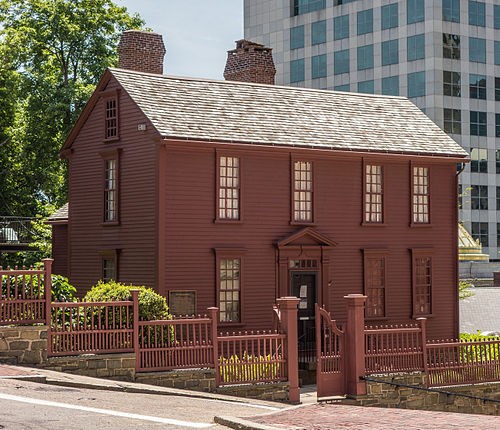Governor Stephen Hopkins House
Introduction
Text-to-speech Audio
Images
Stephen Hopkins House

Backstory and Context
Text-to-speech Audio
The home of Stephen Hopkins is one of the oldest buildings in Providence, and can still be seen at the corner of Hopkins and Benefit Streets. It was first built in 1707, the same year that Hopkins was born. Prior to Hopkins’ purchase of the land, the house was very small. It was a plain structure with one room on the first floor, a small sleeping space above it, and an end chimney. Hopkins bought the home in 1743 and significantly expanded it. He also added his own warehouses and wharves nearby, where his ships docked. He lived in the home for nearly forty years until his death in 1785.
Hopkins enlarged the one room home into an L-shaped, 2 ½ story wood-frame structure. Inside, there is a main parlor room on the right, a study room on the left, and a central hallway with a staircase leading to the five sleeping rooms on the second floor. There is also a small keeping room behind the parlor and another small bedroom located behind Hopkin’s study on the first floor. By 1774 the view from his home at its original located (South Main Street) included the new customhouse and his own warehouses and wharves, where his ships docked.
Stephen Hopkins led a successful career as both a businessman and a politician. When he was just twenty-four years old, he became the Town Clerk in Scituate, Rhode Island and was made President of the Town Council three years later. Eventually, Hopkins moved to Providence with his wife, Sarah. He and his brother, Esek, started their own mercantile-shipping firm in the early 1740s. Their business built and fitted vessels used for commercial shipping. During these years he served in the colonial assembly and as a justice of the colonial high court. Hopkins served as governor of Rhode Island for several terms during 1755 to 1768 (1755-1757, 1758-1762, 1762-1765, and 1767-1768), alternating with Samuel Ward of Newport. In 1776, Hopkins signed the Declaration of Independence and was a member of the First Continental Congress. The house is the only significant structure associated with Hopkins' life.
Alden Hopkins, a descendant of the former governor, designed a small pocket-park around the home in the years after Stephen’s death. The local chapter of the DAR saved the home from destruction in 1927 and moved it to its present location. In the late 1920s the house was carefully restored by Norman Isham. The house is now managed by the National Society of the Colonial Dames of America, and is a museum open to the public. A copy of the Declaration of Independence and a quill pen lie on the desk in the study as a memorial to the homes most famous resident.
Sources
The Stephen Hopkins House. Facebook. Accessed September 24, 2017. https://www.facebook.com/StephenHopkinsHouse/.
Stephen Hopkins. The Society of the Descendants of the Signers of the Declaration of Independence. December 11, 2011. Accessed September 24, 2017. http://www.dsdi1776.com/signers-by-state/stephen-hopkins/.
